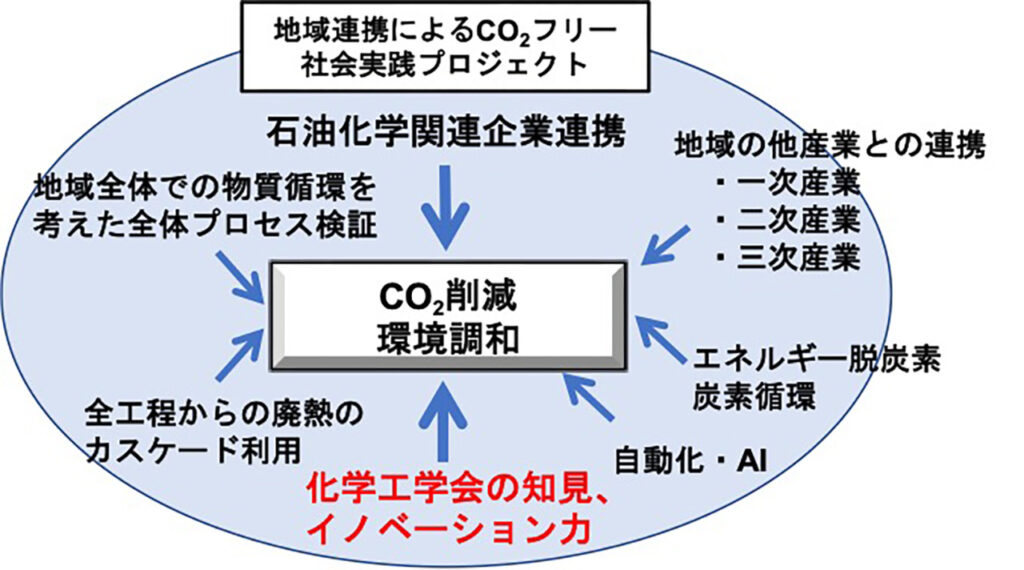Achieving carbon neutrality and developing the chemical industry through regional and inter-industry collaboration
Updated by Yoshiko Tsuji on July 10, 2025, 9:23 AM JST
Yoshiko TSUJI
Center for Environmental Safety Research, The University of Tokyo
Professor, Center for Environmental Safety Research, The University of Tokyo / Chairman, Committee on Carbon Neutrality Promotion for Regional Cooperation, The Society of Chemical Engineers, Japan / Doctor of Engineering / Graduated from the Department of Industrial Chemistry, Graduate School of Engineering, The University of Tokyo in 1990. After working for Toshiba Corporation and the California Institute of Technology, he is currently affiliated with the University of Tokyo. He is engaged in research on functional materials that make effective use of resources for a sustainable society, as well as the creation of environmental safety studies and the development of environmental safety education methods in the field of research and education where technology and people are closely and intricately interrelated. He has been appointed as the chairman of the Carbon Neutrality Promotion Committee of the Society of Chemical Engineers, Japan since 2021. He has announced his vision of carbon independence and is actively involved in promoting industry-academia collaboration to realize a biomass chemical industry that utilizes domestic forest resources and other resources.The Society of Chemical Engineers of Japan, Committee for Promotion of Carbon Neutrality in Regional Cooperation
With the goal of reducing greenhouse gas emissions to virtually zero by 2050, multifaceted efforts in technology, policy, and regional cooperation are being accelerated around the world. However, by combining existing and new technologies to forecast a future society, will it be possible to achieve carbon neutrality in 2050 and carbon negativity beyond that?
From the viewpoint of efficiency, domestic industries have already reached the limit of process optimization within each industry and each company's business site. Rather, as a result of technological innovation since the high-growth period, Japanese industry is characterized by the fusion of several processes within an entire factory, the interlocking of heat, material, and energy transfers, and the optimization of the overall system, while balancing the need for high product performance.
In the future, along with the introduction of new technologies, it will be possible to seek more optimal solutions by integrating the processes of multiple companies in the region. Furthermore, it will be possible to construct a new scenario by integrating not only with the chemical industry, but also with other industries in the region, as well as with the local community (civic life). In other words, when an optimal scenario solution cannot be obtained, it is important to consider expanding the system boundary.

On the other hand, industrial and social structures, whether domestic or foreign, vary from region to region and change over time. Therefore, in carbon neutrality measures, it is important to construct scenarios that take regions and time-series into consideration. In order to construct scenarios for future societies, it is essential to have a neutral position to examine and facilitate the overall picture based on academic studies. In addition, it is no exaggeration to say that local companies and local governments working together under the facilitator are directly linked to all stakeholders taking action by considering the global issue of carbon neutrality as their own.
One example is the carbon neutral project of the Shunan Industrial Complex, which is being undertaken by the Society of Chemical Engineers, Japan (*1). The Shunan Industrial Complex is characterized by (1) a fusion of inorganic chemistry centered on caustic soda and organic chemistry based on olefins, (2) the concentration of diverse materials-based industries such as steel, cement, and fine chemicals, (3) the presence of by-product hydrogen, and (4) a high percentage of coal-fired power generation.
Here, through collaboration between local industries and the local community, they have announced a grand design to reduce CO2 emissions by 50% by 2035, to be carbon neutral by 2050, and to be carbon negative beyond that. In order to achieve net zero CO2 emissions from energy supply, raw material procurement, manufacturing, utilization, and disposal, we are working with the companies that make up the industrial complex and the city of Shunan to optimize the system and develop new processes. In doing so, it is necessary to optimize the entire system while comprehensively considering the establishment of business feasibility, development of systems and regulations for social diffusion, social acceptability, and securing human resources, as well as considering multifaceted value criteria in the future society. (Professor Yoshiko Tsuji, Research Center for Environment and Safety, The University of Tokyo)
Reference Site
1:Shunan Industrial Complex Decarbonization Promotion Council